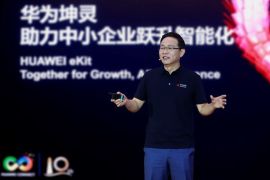“5G developed faster than we had expected. More than 140 commercial 5G networks have been deployed in 59 countries,” said Ryan Ding, Executive Director and President of Carrier Business Group Huawei at Huawei's online media and analyst pre-briefing for the MWC Shanghai 2021.
According to Mr. Ding, Huawei worked closely with customers to navigate through difficult 2020 by supporting the stable operations of over 300 networks across more than 170 countries.
It also helped operators provide online services and minimize the impact of the pandemic on their business. Working with Huawei, operators attracted 22 million new wireless home broadband users worldwide.
“Thanks to this, people can easily access telemedicine services and work from home,” Mr Ding said. He also said the ecosystem is also maturing.
Mr. Ding continued, In China, more than 68% of smartphones shipped in 2020 were 5G phones. "More than 200 5G modules and industrial devices are now available, supporting 5G application in a broad range of industries,” Mr. Ding said.
Huawei helped operators build the best networks. According to the 2020 reports from third parties, including IHS, P3, OpenSignal and Meqyas, the best 5G networks in Seoul, Amsterdam,
Madrid, Zurich, Hong Kong and Riyadh were all the networks built by Huawei. Mr. Ding stressed that great network experience is the foundation of business success, and that these 6 cities are just a tip of the iceberg in terms of Huawei’s collaborative innovation with operators. For instance, by deploying Huawei’s 64T64R AAUs and leading multi-antenna algorithms, LG U+ achieved higher spectrum efficiency and network experience more than 25% better than other operators. With Huawei’s Blade AAU, which can operate in both Sub3G and C-Band, Sunrise shortened site acquisition time from 24 months to 6 months, and was only operator with 5 straight outstanding ratings in Switzerland.
Mr. Ding was optimistic about the prospect of large-scale deployment of 5G industrial applications in 2021 since 5G is becoming part of core production processes in industries.
5G applications have been deployed in more than 20 industries, including manufacturing, healthcare, education and logistics.
''5G is no longer for early adopters, it is improving our daily lives. 2021 will be the first year with large-scale 5G industry applications. Operators will need new capabilities in network planning, deployment, maintenance, optimization, and operations, in order to achieve “0 to 1”, and replicate success from 1 to many. Huawei will have exhibitions and in-depth discussions on these topics with industry stakeholders online and offline at the upcoming MWC Shanghai.
We will keep innovating to help our customers build the best 5G networks and achieve greater business success,” Mr. Ding said.
He pointed to examples in China where 5G industrial applications are already proving their worth, such as in coal mining, steel making and manufacturing, where the adoption of 5G has made production safer, more intelligent, and more efficient.
Elsewhere, sharing similar optimism, Mr. Ritchie Peng, President of Huawei's 5G Product Line, said the deployment of 5G is accelerating worldwide.
“The number of 5G users globally has reached 200 million, and 800,000 5G sites have been constructed worldwide. The overall user experience has been improved by more than tenfold, and entry-level 5G terminals are already available at a price as low as US$350,” Mr Ritchie said.
He attributed a number of factors driving the rapid growth of 5G networks across the industry chain, particularly to the sustained innovation by telecom carriers on services; device vendors on product forms and new applications; and system equipment vendors on systems, algorithms, and solutions; as well as industry customers on vertical applications.
Carriers outside China can quickly deploy 5G Massive MIMO at sites that do not have enough space for new antennas thanks partly to the success of China's network to scaled deployment of Massive MIMO on TDD medium bands that provide a large bandwidth, through which 5G networks can provide huge capacity and ensure continuous coverage.
Huawei's innovative 5G medium-band products and solutions are helping operators provide high-quality 5G network services, as shown in the third-party tests conducted in South Korea,
Germany, Austria, Saudi Arabia, and other countries and regions, during which even if carriers do not have an advantage in spectrum, their user experience still leads by10% to 50% with the same 5G devices.
Reporter: PR Wire
Editor: PR Wire
Copyright © ANTARA 2021












